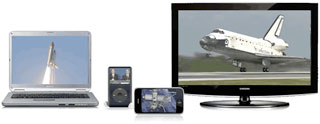New Sharper Views of Apollo Landing SitesThe tracks made in 1969 by astronauts Pete Conrad and Alan Bean, the third and fourth humans to walk on the moon, can be seen in this LRO image of the Apollo 12 site. The location of the descent stage for Apollo 12's lunar module, Intrepid, also can be seen. Conrad and Bean performed two moon walks on this flat lava plain in the Oceanus Procellarum region of the moon. In the first walk, they collected samples and chose the location for the lunar monitoring equipment known as the Apollo Lunar Surface Experiments Package (ALSEP). The ALSEP sent scientific data about the moon's interior and surface environment back to Earth for more than seven years. One of the details visible in this image is a bright L-shape that marks the locations of cables running from ALSEP's central station to two of its instruments. These instruments are probably (left) the Suprathermal Ion Detector Experiment, or SIDE, which studied positively charged particles near the moon's surface, and (right) the Lunar Surface Magnetometer, or LSM, which looked for variations in the moon's magnetic field over time; these two instruments had the longest cables running from the central station. Though the cables are much too small to be seen directly, they show up because the material they are made from reflects light very well. In the second moon walk, Conrad and Bean set out from the descent stage and looped around Head crater, visiting Bench crater and Sharp crater, then headed east and north to the landing site of Surveyor 3. There, the astronauts collected some hardware from the unmanned Surveyor spacecraft, which had landed two years earlier. The two astronauts covered this entire area on foot, carrying all of their tools and equipment and more than 32 kilograms (roughly 60 pounds) of lunar samples. Credit: NASA/Goddard/ASU |

Space video for your computer, iPod or big screen TV
Experience the space program like never before become a subscriber today |


